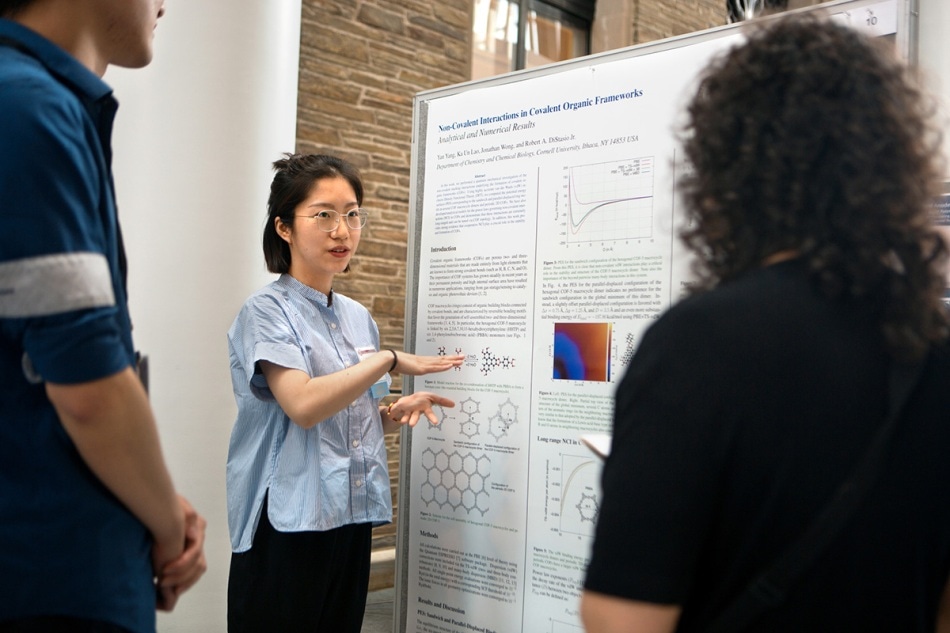Jun 27 2017
On hearing the term origami, folded paper cranes are what normally come to our mind. However, recently, Researchers from the Cornell University have observed the prospects for nanoscale machinery in origami.
 Yan Yang, a graduate student in the field of chemistry and chemical biology, explains her research on “Non-Covalent Interactions in Covalent Organic Frameworks.” CREDIT: Jason Koski/University Photography.
Yan Yang, a graduate student in the field of chemistry and chemical biology, explains her research on “Non-Covalent Interactions in Covalent Organic Frameworks.” CREDIT: Jason Koski/University Photography.
On 16th and 17th June 2017, the Cornell Center for Materials Research (CCMR) conducted a symposium in the Physical Sciences Building to investigate the use of origami to develop micron-scale machines by using atomically thin materials.
According to Itai Cohen, Co-organizer of the symposium titled “Atomic Origami: a Technology Platform for Nanoscale Machines, Sensors and Robots” which was attended by Scientists from a broad array of origami-related fields, the aim of the symposium was to form connections, bridges and possible collaborations. Itai Cohen is also the Associate Professor of Physics in the College of Arts and Sciences, and stated that the half century old CCMR ‒ including three interdisciplinary research teams with 100 faculty from 12 departments and four colleges at Cornell University ‒ was a perfect host for the symposium.
The National Science Foundation and New York state jointly fund the CCMR, which is an interdisciplinary research center, for investigating materials and developing them by means of experimental, fundamental, as well as theoretical research works. CCMR also organizes educational outreach to Students and Teachers, knowledge transfer and industrial outreach, and conducts shared instrumentation for assisting on-campus and off-campus materials research, accessible to all who are willing to take part. Corning Inc. co-sponsored the symposium.
It was wonderful to have the opportunity to listen to and interact with world-class experts in this fascinating field of origami research. CCMR continues to be a great partner because of the access they provide to world-class equipment, services and most importantly ‒ people.
Dan Vaughn, Manager of External Technology Collaborations and Intellectual Assets, Corning
By making use of the fundamentals of origami, Researchers are developing two-dimensional designs on plastics, metals and polymers by applying mathematical principles and folding and transforming them into three-dimensional objects. The technique is specifically robust as the mechanics are such that it moves both up and down, typically folding precisely the same manner irrespective of size.
The scalability is the reason these kinds of paper arts are showing up all over the place: architectural scale structures, human scale, micron scale, flying robots, little polymer structures that swell or unswell, or even structures like solar panels deploying in space.
Paul McEuen, Conference Co-organizer and the John A. Newman Professor of Physical Science
Marc Miskin, a Postdoctoral Associate at Cornell University, outlined the prospects for micron-scale machinery in his lecture, “2D Materials for the Fabrication of Micron-Sized, Autonomous Origami Machines.” “Using conventional lithography, each device could carry more processing power than Voyager and remain small enough for injection into the body,” he stated. “They’d be comparable in size to a biological machine.”
According to Cohen, “Although origami has many niche markets that it’s already influencing, our vision of making origami as an enabling platform for microscale robots is totally untapped.”
According to Cohen, the poster session of the symposium that enables industry representatives to have a glimpse of the broad range of research related to CCMR generally kindles interest in partnerships between industry partners, which took place again at this symposium. In order to advance such collaborations, CCMR provides funding mechanisms for industry support, for example, the Industrial Collaboration Program.
The entire conference had this spirit of pie-in-the-sky, let’s dream a little bit about where this could go. We had everything from new sensors that changed their photonic properties based on chemical absorptions that could indicate rotting food, to little tiny robots that get injected into the cerebral-spinal fluid that can be used to interface with the brain.
Itai Cohen, Co-organizer of the symposium